Some daily events in the changing sky for November 19 – 27
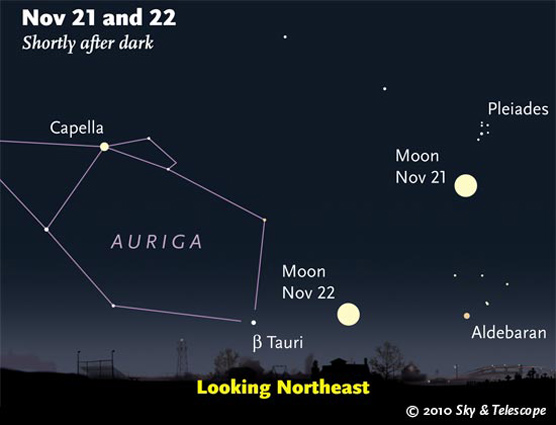
When the Moon is full in November, it always shines near the stars of Auriga and Taurus.
Sky & Telescope diagram
Friday, November 19
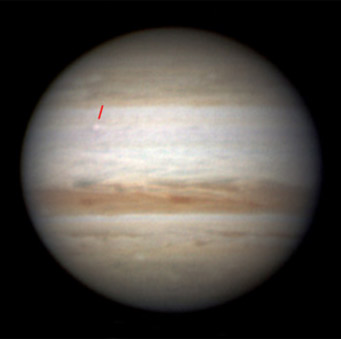
A new bright white spot (indicated) in the latitude of Jupiter 's South Equatorial Belt was the first sign of events that will probably lead to the whole belt's return. Discoverer Christopher Go took this image at 10:24 UT November 10th. Compare with the later images below. South is up.
Saturday, November 20
Sunday, November 21
Monday, November 22
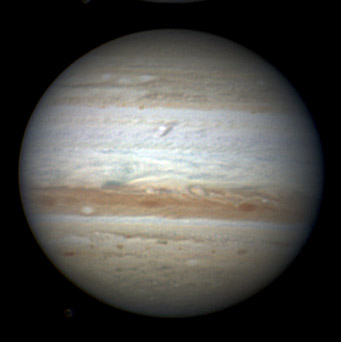
Just above center, the tiny new white spot had already grown a striking border of dark material by November 12th. Methane-band images confirmed that the white spot was boiling up thunderhead-style to an unusually high altitude in Jupiter's atmosphere. See our article Jupiter's Lost Belt Reviving?, and keep watch for yourself!
Christopher Go took this image at 11:17 UT November 12th, when the System II longitude on Jupiter's central meridian was 292°. South is up.
Tuesday, November 23
Wednesday, November 24
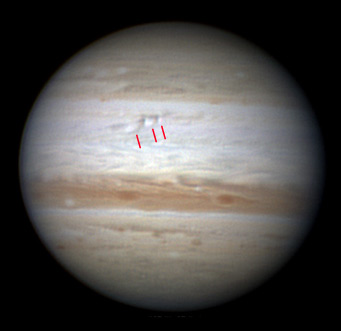
November 17th: Three outbreaks now, all in a row! Again, methane-band imagery confirms that the newest, smallest white spot is at a very high altitude, while the older two seem to be sinking back down. South is up.
Thursday, November 25
Inside the Summer Triangle, can you spot the little constellation Sagitta, the Arrow, halfway from Altair to the Triangle's center?
Friday, November 26
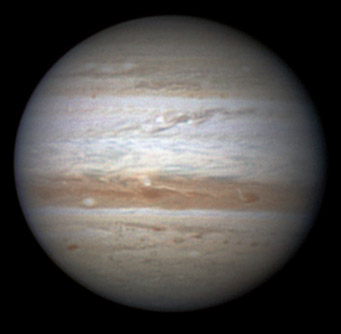
By November 24th, dark material was spreading far from the outbreak region.
Saturday, November 27
Sky at a Glance is now an iPhone app! Put S&T SkyWeek on your iPhone, iPad, or iPod Touch and get the above listings anytime, anywhere — with interactive sky maps! Tap a button to see the scene described, customized for your location worldwide. From there you can scroll the view all around the sky, zoom in or out, change to any time or date, and turn on animation. Go to Apple's iTunes store from your device and buy S&T SkyWeek — just 99 cents!
Want to become a better amateur astronomer? Learn your way around the constellations. They're the key to locating everything fainter and deeper to hunt with binoculars or a telescope.
For an easy-to-use constellation guide covering the whole evening sky, use the big monthly map in the center of each issue of Sky & Telescope, the essential magazine of astronomy. Or download our free Getting Started in Astronomy booklet (which only has bimonthly maps).
Sky Atlas 2000.0 (the color Deluxe Edition is shown here) plots 81,312 stars to magnitude 8.5. That includes most of the stars that you can see in a good finderscope, and typically one or two stars that will fall within a 50× telescope's field of view wherever you point. About 2,700 deep-sky objects to hunt are plotted among the stars.
Alan MacRobert
Once you get a telescope, to put it to good use you must have a detailed, large-scale sky atlas (set of charts). The standards are the Pocket Sky Atlas, which shows stars to magnitude 7.6; the larger Sky Atlas 2000.0 (stars to magnitude 8.5); and the even larger and deeper Uranometria 2000.0 (stars to magnitude 9.75). And read how to use your charts effectively.
You'll also want a good deep-sky guidebook, such as Sky Atlas 2000.0 Companion by Strong and Sinnott, or the more detailed and descriptive Night Sky Observer's Guide by Kepple and Sanner, or the classic if dated Burnham's Celestial Handbook.
Can a computerized telescope take their place? I don't think so — not for beginners, anyway, and especially not on mounts that are less than top-quality mechanically. As Terence Dickinson and Alan Dyer say in their Backyard Astronomer's Guide, "A full appreciation of the universe cannot come without developing the skills to find things in the sky and understanding how the sky works. This knowledge comes only by spending time under the stars with star maps in hand."
This Week's Planet Roundup
Mercury (magnitude –0.4) is deep in the glow of sunset. Look for it above the southwest horizon in bright twilight; binoculars will help. They may also reveal much fainter Mars nearby.
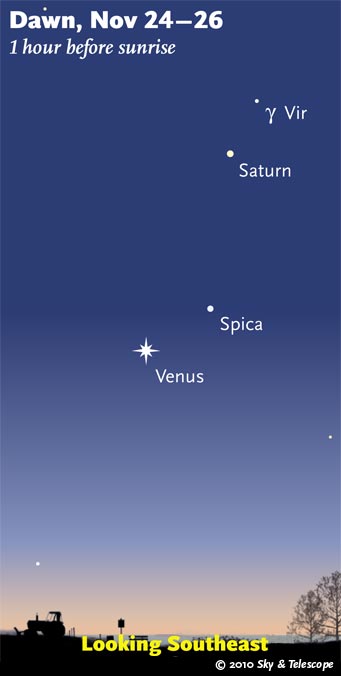
Venus light the way to lesser objects low in the pre-sunrise sky.
Sky & Telescope diagram
Venus, magnitude –4.6, is rapidly gaining altitude as the bright "Morning Star" before and during dawn. Look east-southeast. To its upper right is much fainter Spica, and higher above them is Saturn.
Mars, magnitude +1.4, is near brighter Mercury after sunset. Using binoculars, look for it 2° upper right of Mercury on Friday evening the 19th, and increasingly far to Mercury's right later in the week.
Jupiter (magnitude –2.6, at the Pisces-Aquarius border) shines high in the south during evening, the brightest starlike point in the sky. In a telescope it's still 44 arcseconds wide. Jupiter's missing South Equatorial Belt may finally be about to re-form, heralded by a series of telltale bright spots that appeared more than a week ago. See our article Jupiter's Lost Belt Reviving?.
As for Jupiter's Great Red Spot, it's near System II longitude 157°. Assuming it stays there, here's a list to print out of all the Great Red Spot's predicted transit times for the rest of this observing season.
Saturn (magnitude +0.9, in Virgo) glows in the east-southeast before and during dawn, about 15° above bright Venus. The best time to observe Saturn with a telescope is perhaps an hour before your local sunrise time, when the planet will be less blurred by the low-altitude atmospheric mess. Saturn's rings have widened to 9° from edge-on.
Uranus (magnitude 5.8) is 3° east of Jupiter.
Neptune (magnitude 7.9, in Capricornus) is still high in the south-southwest right after dark. See our finder charts for Uranus and Neptune online or, with article, in the September Sky & Telescope, page 56. Can you see any color in Uranus and/or Neptune?
Pluto (magnitude 14.0, in Sagittarius) is lost in the sunset.
All descriptions that relate to your horizon — including the words up, down, right, and left — are written for the world's mid-northern latitudes. Descriptions that also depend on longitude (mainly Moon positions) are for North America. Eastern Daylight Time (EDT) equals Universal Time (also known as UT, UTC, or GMT) minus 4 hours.
To be sure to get the current Sky at a Glance, bookmark this URL:
http://SkyandTelescope.com/observing/ataglance?1=1
If pictures fail to load, refresh the page. If they still fail to load, change the 1 at the end of the URL to any other character and try again.
 0
0
Comments
You must be logged in to post a comment.